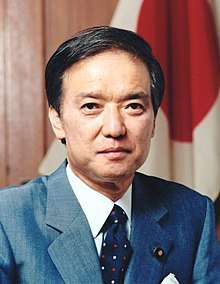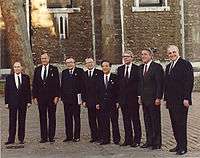Toshiki Kaifu
Toshiki Kaifu (海部 俊樹, Kaifu Toshiki, born 2 January 1931) is a Japanese politician who was Prime Minister of Japan from 1989 to 1991.[1]
Toshiki Kaifu | |
|---|---|
海部 俊樹 | |
 Official photograph (1989) | |
| Prime Minister of Japan | |
| In office 10 August 1989 – 5 November 1991 | |
| Monarch | Akihito |
| Preceded by | Sōsuke Uno |
| Succeeded by | Kiichi Miyazawa |
| Member of the House of Representatives for Aichi 9th District | |
| In office 20 November 1960 – 30 August 2009 | |
| Succeeded by | Mitsunori Okamoto |
| Minister of Finance | |
| In office 14 October 1991 – 5 November 1991 | |
| Preceded by | Ryutaro Hashimoto |
| Succeeded by | Tsutomu Hata |
| Minister of Education | |
| In office 28 December 1985 – 22 July 1986 | |
| Prime Minister | Yasuhiro Nakasone |
| Preceded by | Hikaru Matsunaga |
| Succeeded by | Masayuki Fujio |
| In office 24 December 1976 – 28 November 1977 | |
| Prime Minister | Takeo Fukuda |
| Preceded by | Michio Nagai |
| Succeeded by | Shigetami Sunada |
| Preceded by | Seiroku Kajiyama |
| Succeeded by | Hyosuke Kujiraoka |
| Personal details | |
| Born | 2 January 1931 Nagoya, Empire of Japan |
| Political party | Liberal Democratic Party (2003–present) |
| Other political affiliations | Liberal Democratic Party (1960–1994) New Frontier Party (1994–1997) "Assembly of Independents" (1997-1998) Liberal Party (1998–2000) Conservative Party (2000–2002) New Conservative Party (2002–2003) |
| Alma mater | Chuo University Waseda University |
| Signature |  |
Early life and education
Kaifu was born in Nagoya City, Aichi Prefecture, on 2 January 1931. He was educated at Chuo University and Waseda University.
Career

A member of the Liberal Democratic Party (LDP), Kaifu ran successfully for the 1960 Japanese general election and took office as the youngest member of the National Diet.[2] He served for sixteen terms, totaling 49 years. Kaifu was education minister before rising to lead the party after the resignations of Takeshita Noboru and Sōsuke Uno.[3] Facing Yoshiro Hayashi and Shintaro Ishihara,[4] Kaifu was elected on the platform of clean leadership.[5][6] He became the 76th Prime Minister of Japan in August 1989.[7]
On 10 August 1991, Kaifu became the first leader of a major country to make an official visit to China and break China's diplomatic isolation after the Tiananmen Square Incident of June 4, 1989.[8] Kaifu ended Japan's participation in economic sanctions against China and offered $949.9 million in loans and an additional $1.5 million in emergency aid following flood damage in southern China in June and July.[9]
Throughout his two Cabinets, Kaifu's faction was too small to push through the reforms he sought, and the continuing repercussions of the Sagawa Express scandal caused problems. He resigned in November 1991 and was replaced by Kiichi Miyazawa.
In 1994, he left the LDP to become head of the newly founded New Frontier Party.[10][11] He supported Ichirō Ozawa's party until he returned to LDP in 2003.[12] He was defeated in the election of 2009 by DPJ candidate Mitsunori Okamoto,[13] which witnessed the end of almost uninterrupted LDP dominance since 1955.[14] At the time of his defeat, he was the longest-serving member of the lower house of the Diet, and he was also the first former prime minister to be defeated at a re-election since 1963.[15]
Honours
From the corresponding article in the Japanese Wikipedia
- Grand Cordon of the Order of the Paulownia Flowers (July 2011)
In popular culture
Kaifu is one of several world leaders depicted on the cover of Megadeth's 1990 album Rust in Peace.
References
- "Toshiki Kaifu". Inter Press Service. Retrieved 7 January 2013.
- Wiseman, Steven R. (9 August 1989). "Japan's Troubled Successor". New York Times. Retrieved 17 April 2019.
- Yates, Ronald E. (9 August 1989). "New prime minster elected in Japan". Chicago Tribune. Retrieved 17 April 2019.
- Jameson, Sam (5 August 1989). "2 More Join Race for Japanese Premier : Ex-Ministers of Transportation, Health Also Seek to Succeed Uno". Los Angeles Times. Retrieved 17 April 2019.
- "Japanese official quits over affair". New York Times. Associated Press. 25 August 1989. Retrieved 17 April 2019.
- Hiatt, Fred (3 March 1990). "Japan's Kaifu faces new hints of scandal". Washington Post.
- Pringsheim, Klaus H. (1991). "The Political Ordeal of Toshiki Kaifu (1990–1991)". American Foreign Policy Newsletter. 14 (3): 3–17. doi:10.1080/07383169.1991.10392623.
- "Japanese Prime Minister Meets With China's Communist Leader". Associated Press. 12 August 1991. Retrieved 17 April 2019.
- "Prime Minister Toshiki Kaifu departs Saturday for Beijing to..." UPI. Retrieved 22 October 2018.
- "New party taps". Sun Sentinel. 9 December 1994. Retrieved 17 April 2019.
- "Ex-premier to head new Japanese party". Washington Post. 8 December 1994. Retrieved 17 April 2019.
- Dobson, Hugo; Rose, Caroline (2019). "The Afterlives of Post-War Japanese Prime Ministers". Journal of Contemporary Asia. 49 (1): 127–150. doi:10.1080/00472336.2018.1460389.
- Murakami, Mutsuko (1 September 2009). "Untested New Regime Raises Fresh Hopes". Inter Press Service. Retrieved 17 April 2019.
- Maeda, Ko (September–October 2010). "Factors behind the Historic Defeat of Japan's Liberal Democratic Party in 2009". Asian Survey. 50 (5): 888–907. doi:10.1525/as.2010.50.5.888.
- "Several LDP bigwigs sent down to defeat". Japan Times. Kyodo News. 31 August 2009. Retrieved 17 April 2019.
External links
- KAIFU, Toshiki International Who's Who. Retrieved 3 September 2006.
- Appearances on C-SPAN
| Party political offices | ||
|---|---|---|
| Preceded by Sosuke Uno |
Director of Youth Division, Liberal Democratic Party 1966 |
Succeeded by Takasaburo Naito |
| Preceded by Takasaburo Naito |
Director of Youth Division, Liberal Democratic Party 1968-1972 |
Succeeded by Takeo Nishioka |
| Preceded by Sosuke Uno |
Chair of Diet Affairs Committee, Liberal Democratic Party 1976 |
Succeeded by Shintaro Abe |
| Preceded by Sosuke Uno |
President of the Liberal Democratic Party 1989-1991 |
Succeeded by Kiichi Miyazawa |
| New title | Leader of the New Frontier Party 1994-1995 |
Succeeded by Ichiro Ozawa |
| Political offices | ||
| Preceded by Seiroku Kajiyama |
Deputy Chief Cabinet Secretary 1974–1976 |
Succeeded by Hyosuke Kujiraoka |
| Preceded by Michio Nagai |
Minister of Education 1976–1977 |
Succeeded by Shigetami Sunada |
| Preceded by Hikaru Matsunaga |
Minister of Education 1985–1986 |
Succeeded by Masayuki Fujio |
| Preceded by Sōsuke Uno |
Prime Minister of Japan 1989–1991 |
Succeeded by Kiichi Miyazawa |
| Preceded by Ryutaro Hashimoto |
Minister of Finance 1991 |
Succeeded by Tsutomu Hata |
| Honorary titles | ||
| Preceded by Kazuo Tanikawa |
Youngest member of the House of Representatives 1960-1963 |
Succeeded by Ryutaro Hashimoto |